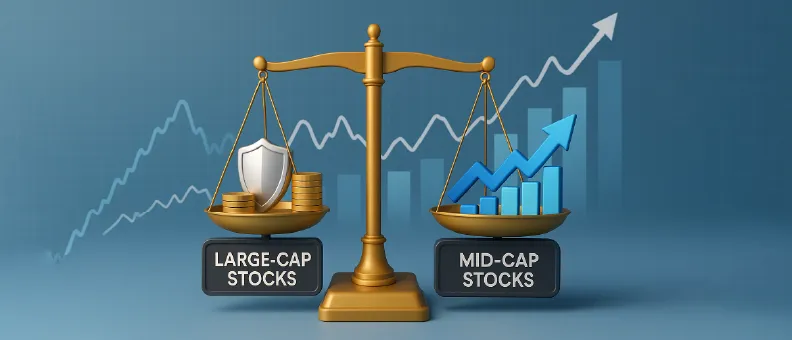How Large And Mid Cap Can Navigate Volatile Markets


Navigating volatile markets can be challenging but understanding how large and mid cap funds behave and how you can strategically use them, can potentially help you weather uncertainty and position your portfolio for long-term growth.
Let’s explore how these funds operate during market swings, their historical performance, and actionable strategies you can use to mitigate risk and optimize return potential.
- Table of contents
- Understanding market volatility and its impact on investments
- How large cap funds respond to market volatility
- How mid cap funds navigate market swings
- Potential benefits of investing in large and mid cap funds during uncertain times
- Diversification: A key strategy with large and mid cap funds
- Risk management strategies for investors
- How to choose a suitable large and mid cap fund
Understanding market volatility and its impact on investments
Market volatility refers to the rapid and unpredictable changes in stock prices. This turbulence can be triggered by global events, economic policy shifts, or sector-specific news. For investors, volatility often means heightened uncertainty, potential short-term losses, and emotional decision-making. However, it also presents opportunities for disciplined, long-term investors to accumulate quality assets at attractive valuations.
How large cap funds respond to market volatility
Large cap funds invest in the top 100 companies by market capitalization, India’s blue-chip giants. These companies are typically well-established, financially robust, and have a proven track record of weathering economic storms.
During volatile periods:
- Stability and resilience: Large cap funds tend to be relatively more stable because their underlying companies have diversified revenue streams, strong balance sheets, and higher liquidity. This can allow them to potentially withstand market shocks better than smaller companies.
- Downside protection: Historically, large cap funds have provided better downside protection and quicker recoveries during market corrections. Investors often flock to these funds for relative stability and potential preservation of capital when uncertainty rises.
- Moderate returns: While they offer stability, large cap funds are not immune to losses. Even blue-chip stocks can be affected by severe corrections, reminding investors that no equity investment is completely risk-free.
Read Also: What are Large and Mid Cap Funds?
How mid cap funds navigate market swings
Mid cap funds invest in companies ranked 101 to 250 by market capitalization. These firms are typically in their growth phase, offering higher return potential but also greater sensitivity to market swings.
- Higher volatility, higher growth: Mid cap funds are more volatile than large caps, typically experiencing sharper declines during downturns but also potentially stronger rebounds in bull markets.
- SIP resilience: Systematic Investment Plans (SIPs) in mid cap funds help investors average out purchase costs over time, mitigating the impact of volatility and enabling potential portfolio growth over a long horizon even in choppy markets.
- Long-term outperformance: Over long periods, SIP investments in mid cap funds have historically delivered positive returns, despite short to mid-term turbulence.
Potential benefits of investing in large and mid cap funds during uncertain times
Large and mid cap funds blend the relative stability of large caps with the long-term growth potential of mid caps. This dual exposure offers several potential advantages:
- Balanced risk and return: By investing at least 35% each in large caps and mid caps, these funds can potentially provide a smoother investment experience than pure mid cap funds while offering relatively better growth prospects than pure large cap funds.
- Diversification: Exposure to both segments means your portfolio is less reliant on the fortunes of a single sector or company size, mitigating overall risk.
- Resilience and upside: During market downturns, large caps may potentially help preserve capital, while mid caps position your portfolio to capture the potential upside when markets eventually recover.
- Liquidity: Large caps can potentially ensure you can enter or exit the fund easily, even during market stress.
Diversification: A key strategy with large and mid cap funds
Diversification is central to navigating volatile markets. Large and mid cap funds inherently diversify your portfolio by:
- Spanning sectors and sizes: These funds invest across multiple industries and company sizes, spreading out sector-specific and company-specific risks.
- Balancing cyclical performance: Large caps may lend stability in bear markets, while mid caps tend to lead during bull runs ensuring your portfolio isn’t overly exposed to one market phase.
- Reducing single-stock risk: With a broad stock universe, underperformance in one company or sector is less likely to derail your entire investment.
Risk management strategies for investors
To navigate volatile markets with large and mid cap funds, consider these risk management strategies:
- Asset allocation: Maintain a balanced mix of equity, debt, and other asset classes based on your risk profile and financial goals.
- Regular reviews: Periodically review your portfolio to ensure it aligns with your objectives and risk tolerance. Rebalance if any segment becomes over- or under-weighted.
- SIP investing: Use SIPs to invest regularly, which helps average out purchase costs and reduces the emotional impact of market swings.
- Long-term perspective: Equity funds, especially those with mid cap exposure, require a long investment horizon (at least five plus years) to ride out volatility and benefit from potential compounding.
- Monitor fund selection: Not all funds perform equally. Pay attention to fund manager track records, expense ratios, and portfolio composition.
How to choose a suitable large and mid cap fund
Selecting a suitable fund involves more than just looking at past returns. Here’s what you should evaluate:
- Investment objective: Align the fund’s strategy with your financial goals—whether it’s wealth creation, retirement, or a specific future expense.
- Risk appetite: Assess your comfort level with volatility. Large and mid cap funds are typically classified as “very high risk,” so ensure you’re prepared for short-term fluctuations.
- Fund manager expertise: Look for funds managed by experienced teams with a consistent track record of navigating different market cycles.
- Expense ratio: Lower costs mean more of your returns stay with you. Compare expense ratios across similar funds.
- Portfolio transparency: Review the fund’s holdings to ensure a balanced allocation between large and mid caps, and check for excessive concentration in any sector or stock.
Read Also: Difference Between Large Cap, Mid Cap & Small Cap Funds
Conclusion
In today’s unpredictable markets, large and mid cap funds can offer a suitable route to balance relative stability with long-term growth potential. While no fund is immune to volatility, the combination of blue-chip resilience and mid cap dynamism can help you navigate uncertainty with greater confidence. By focusing on disciplined asset allocation, regular investing, and careful fund selection, you can harness the unique strengths of these funds to potentially build long-term wealth, even through the market’s roughest patches. Remember, the key is not to avoid volatility, but to manage it wisely and stay committed to your financial journey.
FAQs:
What makes large and mid cap funds suitable for volatile markets?
They combine the relative stability of large caps with the long-term growth potential of mid caps, offering a balance that can potentially cushion downside risk while participating in market recoveries.
How do large cap and mid cap funds differ in risk and returns?
Large cap funds are relatively less volatile and provide steadier potential returns, while mid cap funds are more volatile but offer higher long-term growth potential. Large and mid cap funds sit between these extremes, balancing risk and reward.
Are large and mid cap funds good for long-term investment during market uncertainty?
Yes, with a recommended horizon of five years or more, these funds have historically delivered risk-adjusted returns and can potentially help you ride out short-term volatility.
How can I minimise risk when investing in large and mid cap mutual funds?
Use SIPs to average out costs, diversify across sectors, review your portfolio regularly, and align your investments with your risk tolerance and goals.
What factors should I consider before choosing a large and mid cap fund?
Consider your investment objective, risk appetite, fund manager expertise, expense ratio, portfolio composition, and the fund’s performance consistency across market cycles.
Mutual Fund investments are subject to market risks, read all scheme related documents carefully.
This document should not be treated as endorsement of the views/opinions or as investment advice. This document should not be construed as a research report or a recommendation to buy or sell any security. This document is for information purpose only and should not be construed as a promise on minimum returns or safeguard of capital. This document alone is not sufficient and should not be used for the development or implementation of an investment strategy. The recipient should note and understand that the information provided above may not contain all the material aspects relevant for making an investment decision. Investors are advised to consult their own investment advisor before making any investment decision in light of their risk appetite, investment goals and horizon. This information is subject to change without any prior notice.
The content herein has been prepared on the basis of publicly available information believed to be reliable. However, Bajaj Finserv Asset Management Ltd. does not guarantee the accuracy of such information, assure its completeness or warrant such information will not be changed. The tax information (if any) in this article is based on prevailing laws at the time of publishing the article and is subject to change. Please consult a tax professional or refer to the latest regulations for up-to-date information.